Volvox sp.
Biology
The spherical green alga Volvox sp. marks the stage in the development from unicellular to multicellular organisms directly after the constitution of the first multicellular organisms. It is the most advanced and largest host carrier colony (up to 2 mm in diameter), consisting of very many individual cells (max. 20,000), which are stuck at regular intervals in the wall of a hollow gelatinous sphere and turn their 2 flagella outwards. Each individual cell is connected to its neighbours by plasma bridges.
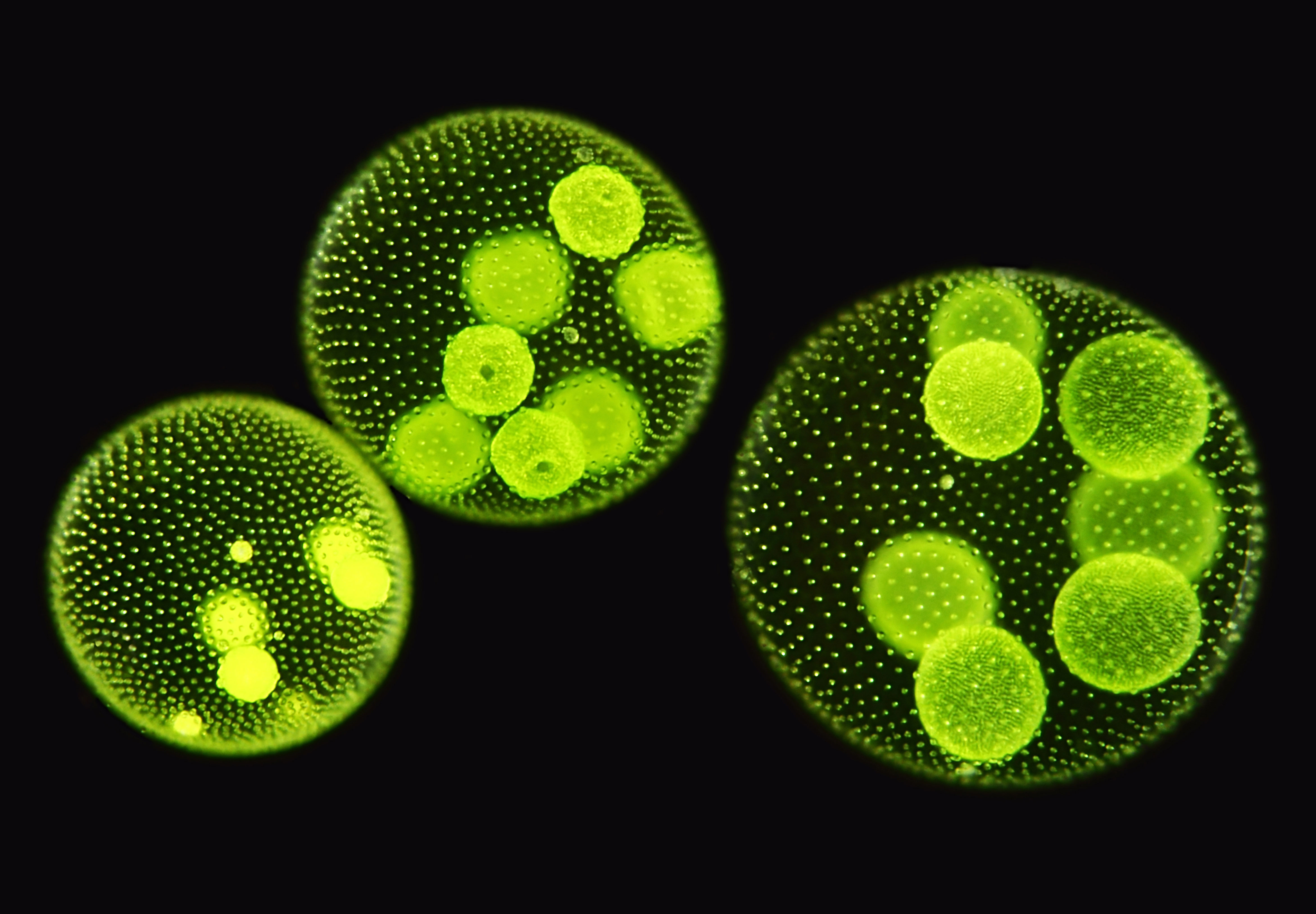
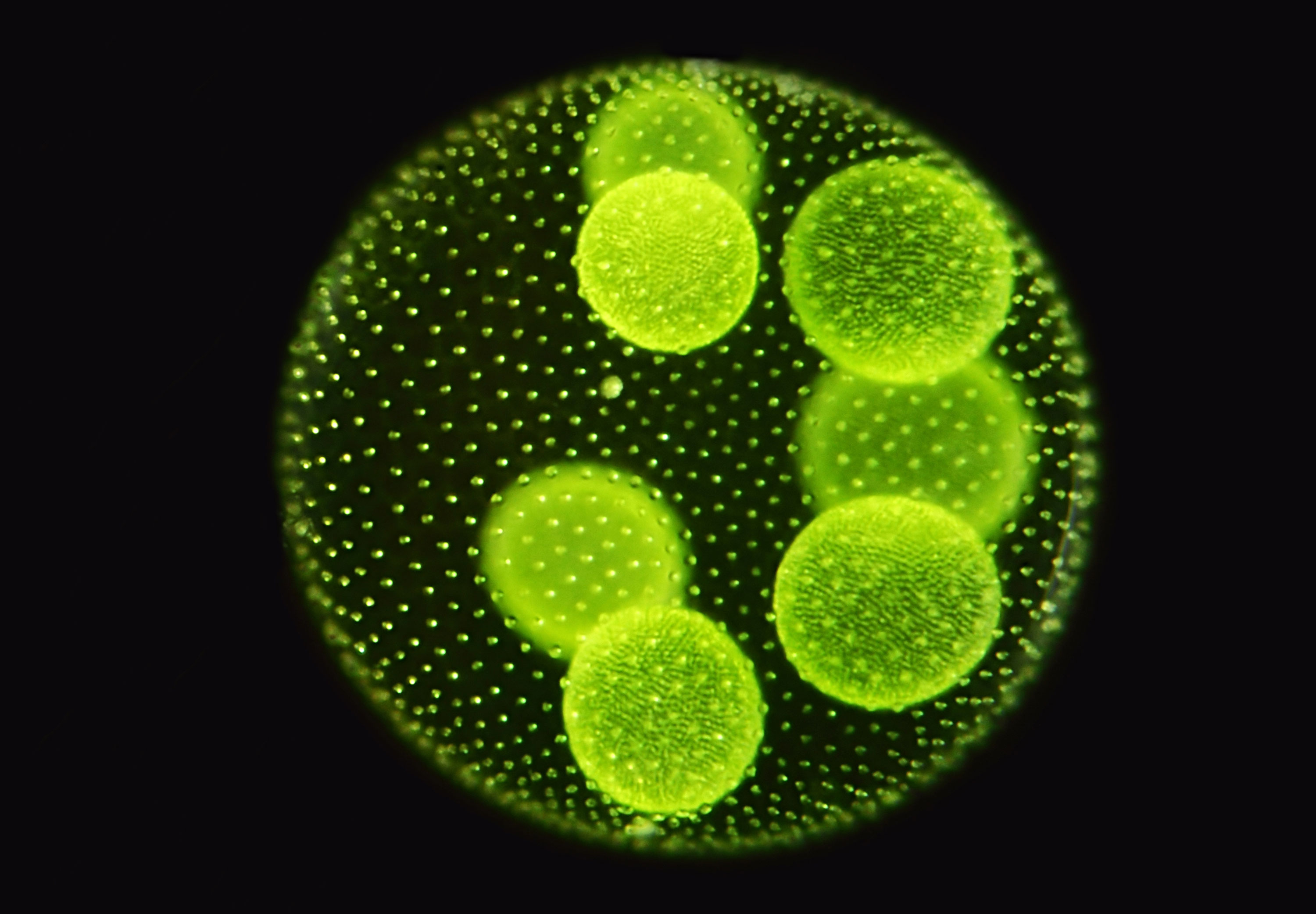
Locomotion is achieved by the common flagellar beat of all cells. The anterior cells have larger eyespots and are more sensitive to light than the cells at the posterior pole. Only a few cells at the rear end of the colony are capable of reproduction (formation of the first germ cells!); they are larger and are pushed into the interior of the colony when they divide. There they grow into new colonies, which are released after the bursting of the mother colony.
At this stage in the development of the organisms, death has now also arrived. Single-celled organisms that reproduce by fission were and are in principle immortal.
Below is a schematic diagram from an old school textbook. The plasma bridges between the cells are shown on the left. Only the larger cell is capable of reproduction. On the right is a schematic representation of the moment when the mother colony bursts and releases the daughter colonies.
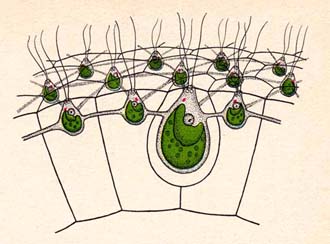
Here is a schematic diagram from an old school textbook.
The plasma bridges between the cells are shown on the left. Only the larger cell is capable of reproduction.
On the right is a schematic representation of the moment when the mother colony bursts and releases the daughter colonies.
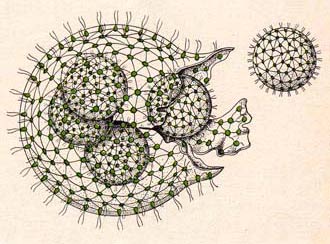
Locomotion is achieved by the common flagellar beat of all cells. The anterior cells have larger eyespots and are more sensitive to light than the cells at the posterior pole. Only a few cells at the rear end of the colony are capable of reproduction (formation of the first germ cells!); they are larger and are pushed into the interior of the colony when they divide. There they grow into new colonies, which are released after the bursting of the mother colony. At this stage in the development of the organisms, death has now also arrived. Single-celled organisms that reproduce by fission were and are in principle immortal.
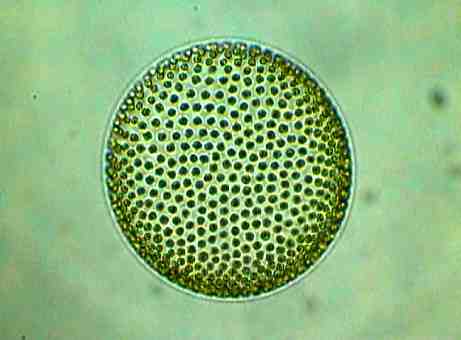
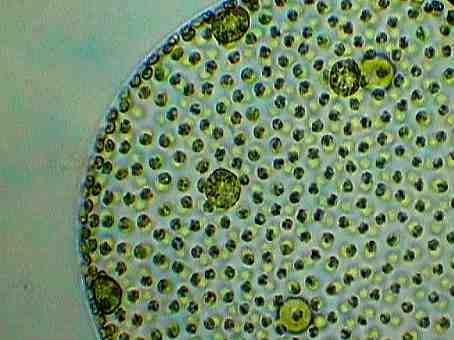
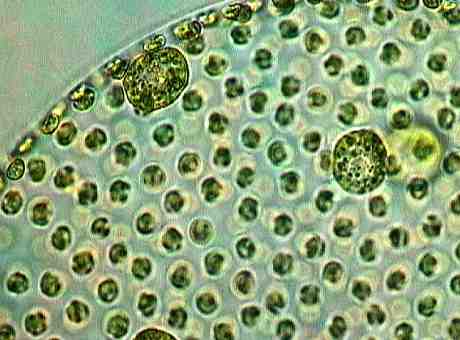
The pictures of this Volvox species, in which you can also recognise the daughter colony formation very well, as well as the following pictures, are from Günter H. Stanjek (the copyright of the photos lies exclusively with him).
For the sake of completeness, I am also including G. H. Stanjek's commentary on the photographed Volvox sp:
"It should be noted, however, that this is a very small species that could not be determined more precisely. It differs considerably in size and habitus from other, better-known species, which normally only occur in eutrophic waters."
Below are some more pictures of Volvox sp. in various stages
The ciliate Volvox loves eutrophic waters, where it can sometimes be observed in dense clouds. The individual spheres, which in some species can be over 1 mm in size, can be recognised with the naked eye as they roll slowly through the water, driven by the simultaneous blinking of all the cells.
These pictures probably show Volvox aureus var. hemisphaerica
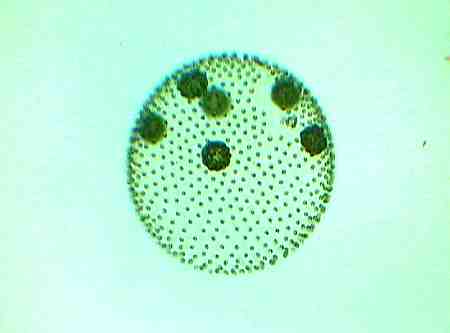
Each sphere consists of up to 3000 individual cells. The daughter colonies develop within the spherical mother colony.
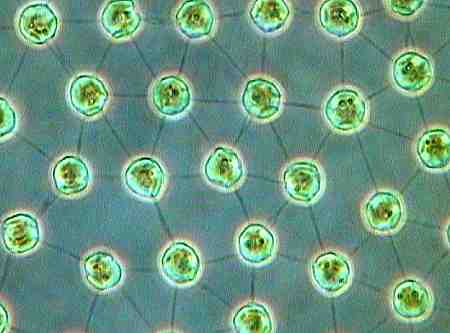
The individual cells, which are approx. 4 µm in size, are connected to each other by wafer-thin plasma filaments, with the cells sitting tightly under the jelly shell.
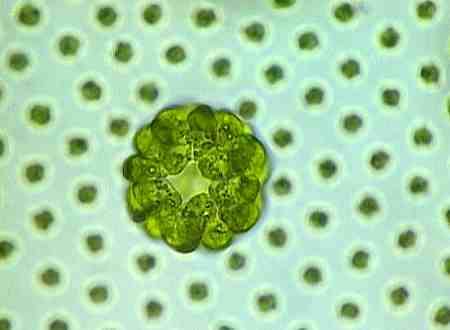
Normally, the daughter colonies are exact replicas of the mother colony, i.e. also spherical colonies.
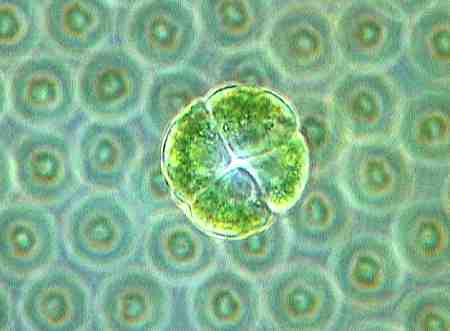
However, if the environmental conditions deteriorate, germ cells are also formed, as in this case, which do not necessarily have to be spherical.
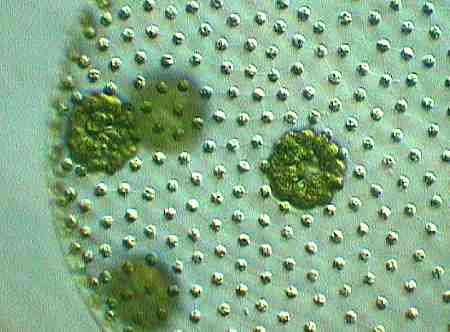
The up to 10 spermatozoid clusters in this species have a diameter of approx. 40 µm.
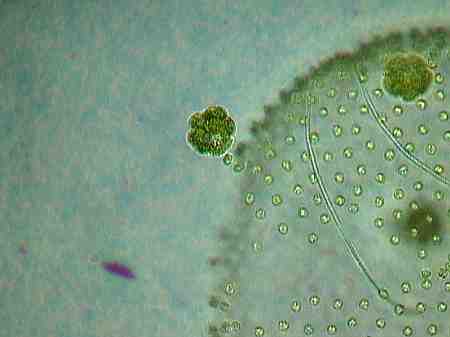
Just like the daughter colonies, the germ cells also leave the mother spheres as a whole.
Culture media
In order to obtain pure cultures, the media should be prepared as sterile as possible. Autoclaving is therefore used in the original recipes.
Instead of using an autoclave, it should be sufficient for initial experiments to heat the solutions to boiling point for 10 minutes, then fill them into clean bottles and seal them tightly. The vitamins must not be heated at the same time as the sensitive substances would otherwise be destroyed.
You can also heat the bubble-free bottles for 10 minutes in a pressure cooker (114 °C).
1st option
Various sources have recommended the use of the French mineral water Volvic.
2nd option
according to Uspanski and Uspanskaja. According to them, previous cultivation attempts often failed due to the iron requirement of Volvox sp.
| Ingredient | Amount |
| KNO3 (potassium nitrate) | 250 mg/l |
| MgSO4 (magnesium sulphate) | 250 mg/l |
| Ca(NO3)2 (calcium nitrate) | 1000 mg/l |
| KH2PO4 (potassium dihydrogenphosphate) | 250 mg/l |
| K2CO3 (potassium carbonate) | 345 mg/l |
| Fe2(SO4)3 (iron (III) sulphate) | 12.5 mg/l |
The amount of iron or the entire nutrient solution must be replaced every 10 days in summer and every 20 days in winter.
3rd option
modified, according to L. Provasoli and I.J. Pintner, 1959, in dist. water
| Ingredient | Amount |
| Ca(NO3)2 × 4 H2O (calcium nitrate) | 118 mg/l |
| MgSO4 × 7 H2O(magnesium sulphate) | 40 mg/l |
| KCl (potassium chloride) | 50 mg/l |
| Na2-glycerophosphate × 5
H2O |
60 mg/l |
| Glycylglycine | 500 mg/l |
| Micronutrient solution | 6 ml |
Micronutrient solution
| FeCl3 × 6 H2O (iron (III) chloride) | 97 mg/l |
| MnCl2 × 4 H2O (manganese (II) sulphate) | 41 mg/l |
| ZnCl2 × 6 H2O (zinc chloride) | 5 mg/l |
| CoCl2 × 6 H2O (cobalt (II) chloride) | 2 mg/l |
| Na2MoO4 × 2 H2O (sodium molybdate) | 4 mg/l |
| EDTA disodium salt dihydrate | 750 mg/l |
Vitamin B1 (500 µg/l) and vitamin B12 (5 µg/l) are added to the finished medium after sterilisation.
4th option
According to instructions from the “Collection of algae cultures” at the Albrecht von Haller Institute for Plant Sciences at the University of Göttingen, Department of Experimental Phycology, quoted by Dr U. G. Schlösser.
The basal medium with 10 % Euglena medium with vitamins is originally used. However, this was originally developed for a bacteria-free culture. However, as this cannot be achieved for aquarium purposes, only 1 to a maximum of 5 % Euglena medium should be added so that the bacteria do not spread too abundantly.
4.1 Basal medium
| Ingredient | Amount |
| KNO3 (potassium nitrate) | 200 mg/l |
| K2HPO4 (dipotassium hydrogenphosphate) | 20 mg /l |
| MgSO4 × 7 H2O (magnesium sulphate) | 20 mg /l |
| Earth decoction* | 5 ml/l |
| Micronutrient solution | 5 ml/l |
* Fill one third of a flask with soil from the garden or deciduous forest (but not too much humus), which must not contain any fertiliser or pesticides. Success depends heavily on the selection of suitable soil, with high clay content being rather unfavourable.
It is covered with deionised water to a height of 5 cm and heated twice in 24 hours for one hour to boil. It is then decanted and separated from particles by filtration (coffee filter!). Pour into small containers that can be easily sterilised in a pressure cooker and then stored in the refrigerator.
4.2 Micronutrient solution
| ZnSO4 × 7 H2O (zinc sulphate) | 1 mg/l |
| MnSO4 × 4 H2O (manganese(II) sulphate) or MnSO4 × H2O |
2 mg/l or 1.5 mg/l |
| H3BO3 (boric acid) | 10 mg/l |
| Co(NO3)2 × 6 H2O (cobalt (II) nitrate) or CoSO4 × 7 H2O (cobalt (II) sulphate) |
1 mg/l |
| CuSO4 × 5 H2O (copper (II) sulphate) | 0.5 µg/l |
| FeSO4 × 7 H2O (iron (II) sulphate) or FeSO4 × H2O |
700 mg/l or 430 mg/l |
| EDTA disodium salt dihydrate | 800 mg/l |
4.3 Euglena medium
| NaOAc (sodium acetate) or NaOAc × 3 H2O |
1 g/l or 1.7 g/l |
| Meat extract | 1 g/l |
| Bacto-tryptones** | 2 g/l |
| Yeast extract | 2 g/l |
| Earth decoction (see basal medium) | 30 ml/l |
**Bacto®-Tryptone (“Pancreatic Digest [→ digestion product] of Casein especially rich in Tryptophane”). Known additive for all types of culture media. Available e.g. from
Becton Dickinson
Tullastrasse 8 - 12
69126 Heidelberg
Phone +49 (0 62 21) 3 05 - 2 76
Fax +49 (0 62 21) 3 05 - 4 00
Vitamin B1 (500 µg/l) and vitamin B12 (5 µg/l) are added to the finished medium after sterilisation.

